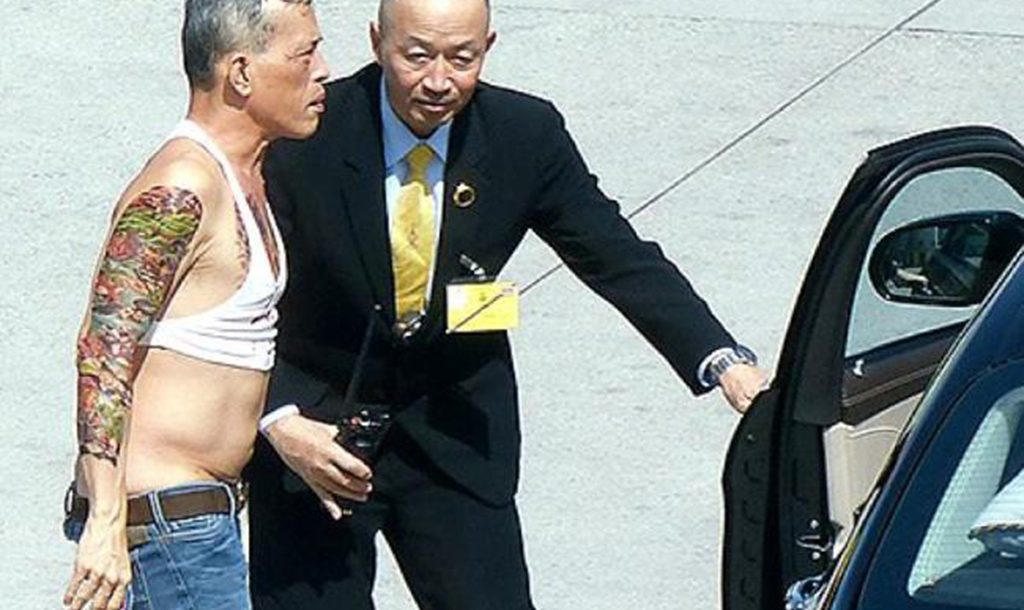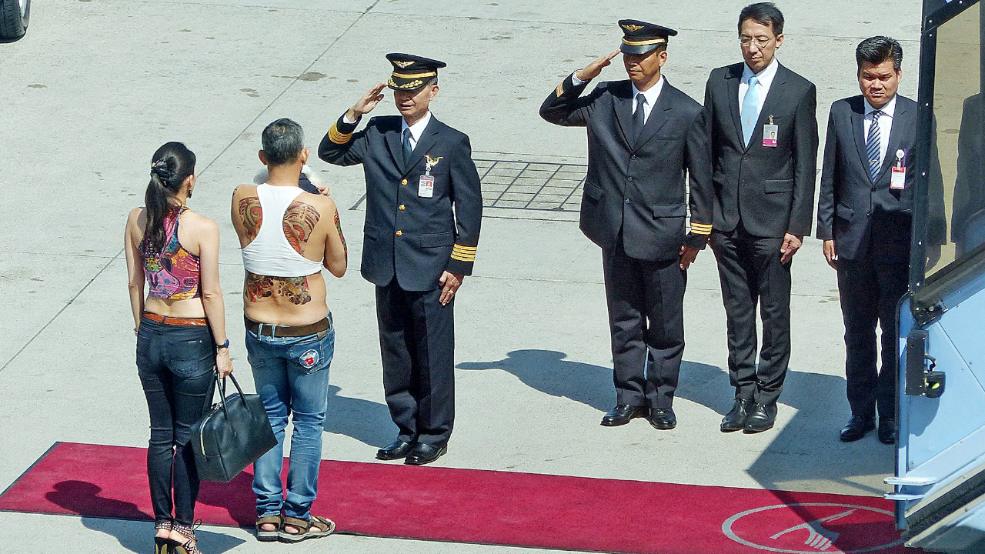Paul Handley takes a closer look at Crown Prince Vajiralongkorn’s tattoos and asks what they could possibly mean.
As we get past the utter shock at the pictures published in Bild of Crown Prince Vajiralongkorn sporting fresh tattoos and a weirdly undersized shirt as he gets on his plane in Munich, the question of what he chose to decorate his body with, and why, is perhaps more interesting.
The Thai police says the photos were doctored, but Bild doubled down and republished them with a fresh article on the prince on Friday. I’m going to assume the powerful newspaper determined they are genuine.
We might chalk it up to the normal yearnings of a middle-aged — well, almost 64-year-old — man who already has a Porsche, a palace, and, according to the same report, a 10 million euro villa on a lake south of Munich.
But seen in the context of his expected succession to the throne, and the games of power going on in Thailand, it would be interesting to get the views of all those historians and cultural anthropologists out there. What does it mean, ritualistically, to be tattooed on the cusp of rising to such a powerful position? And what is the meaning of his choice of tattoos?
The design on his back is not clear, mostly covered by that teensy tank top, but it appears to be a Japanese- (or Chinese-) style tiger. I can’t see what he has on his arm, it’s impossible to tell from the online photos. It’s clearly not a Maori design, which is really so 1990s anyway. It looks fairly elaborate and could be, if I am correct about the the back tattoo, also a Japanese design.
And he definitely has something on his chest as well, but it is too hard to see to even hazard a guess.
What I find interesting is that the Thailand born-and-raised prince has apparently shrugged off the Thai tattoo culture all around him for, possibly, Japanese traditional yakuza style tattoos or, if I’m wrong about that, a non-Thai design, and somethng more globally popular.
I know little about sak yant, but that such tattoos can deliver protection and project power, as much as amulets. I would have thought that a prince interested in power, impressing, dominating or putting fear into his subjects, would make use of such symbols to do so.
But Vajiralongkorn doesn’t appear to feel that need, even as many politicians, powerful businessmen and top generals he comes in contact with do. I’m not sure, but I don’t remember seeing him in pictures with amulets.
Could this be a kind of declaration of separateness from Thai culture, that he is not bound by all the tradition the Chakri throne is supposed to embody? A break with all his father stands for? Or perhaps the meaning and power of sak yant has been degraded since Angelina Jolie got hers and launched Thai tattoo tourism?
Arguably Prince Vajiralongkorn, after his older sister Ubolratana (or “Julie”), is the most international of the royal family, spending generous amounts of time in Germany for more than a decade, hiking, biking and driving around Bavaria clad in sandals and skinny jeans — and getting tattooed — like everyone else. Is this just a demonstration of his global sense? Could that connect him with the younger generation of urban, globalised Thais?
Or, perhaps, does a yakuza-style tattoo carry similar weight in Thailand? (Or is it too degraded by the explosion of skin art around the world?)
There are lots of things to think about with this. Again, I’m sure all those cultural anthropologists out there have a view. Let’s hear!
Paul Handley is a journalist and author of The King Never Smiles: A Biography of Thailand’s Bhumibol Adulyadej.
 Facebook
Facebook  Twitter
Twitter  Soundcloud
Soundcloud  Youtube
Youtube  Rss
Rss 
